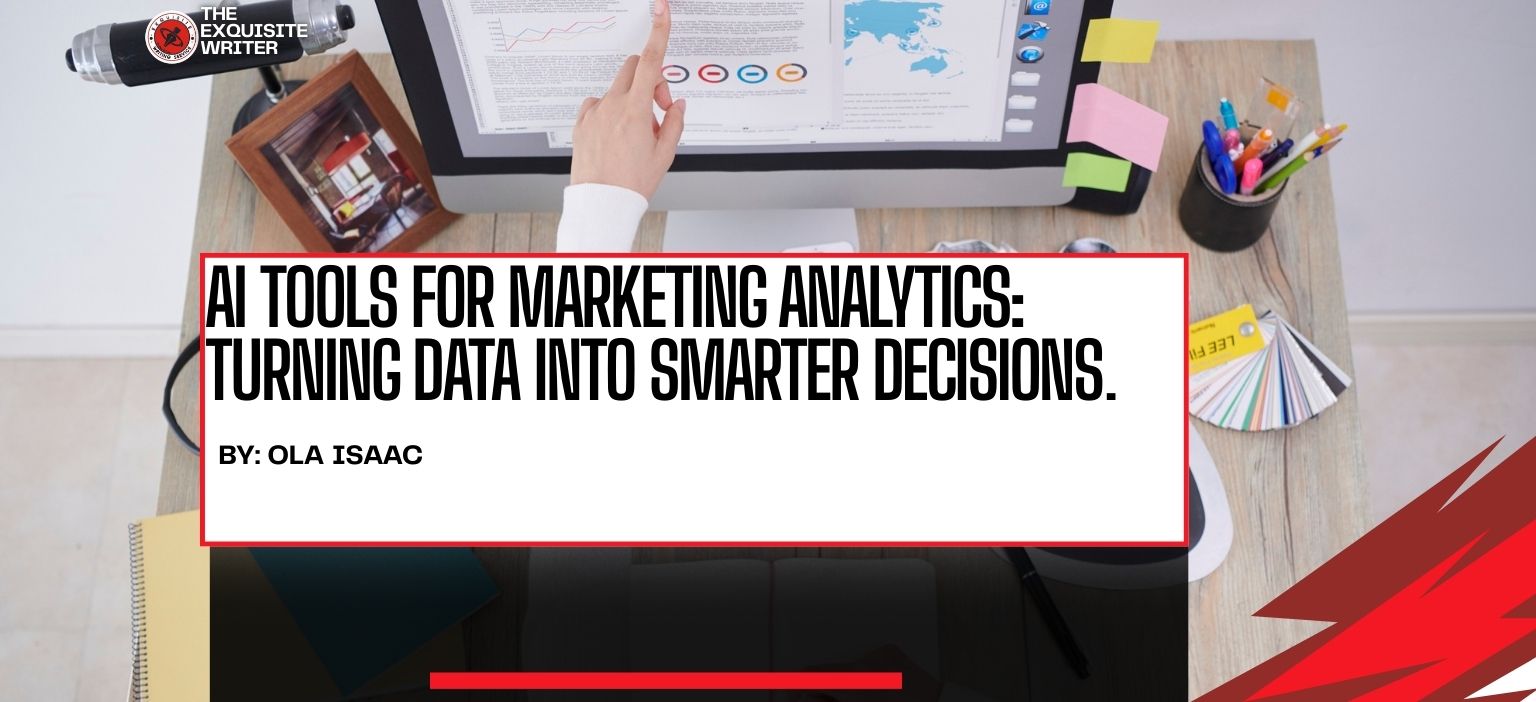If you agree that data is the backbone of modern marketing, then you’ve made the right choice to explore AI tools for marketing analytics.
As McKinsey highlights, modern organizations rely heavily on data-driven decision-making, and AI is becoming essential for turning raw data into actionable insights.
With endless clicks, conversions, impressions, and customer behaviors, marketers face an unprecedented challenge: too much information and not enough clarity.
Hence, exploring AI tools for marketing analytics will let you win the game.
Instead of spending hours sifting through spreadsheets, AI can swiftly analyze massive datasets in seconds, uncover patterns, and even predict what your customers will do next.
With what result? Smarter, faster, and more confident marketing decisions!
In this article, you will explore why AI is transforming marketing analytics, the best AI tools for marketing analytics available, and how you can use them to drive real results.
But why should you use AI for marketing analytics?

Why Use AI for Marketing Analytics?
Traditional analytics platforms tell you what happened. However, with AI-powered analytics, you will take a step further. It will show you why it happened and what to do next.
Research from Harvard Business Review highlights that AI enhances prediction, personalization, automation, and overall marketing decision-making.
Here’s how AI makes a difference:
- Automates data processing: No more manual reporting. AI tools can clean, organize, and visualize data instantly.
- Reveals hidden patterns: AI algorithms spot trends you might miss, like micro-shifts in customer behavior.
- Predicts outcomes: AI can forecast campaign performance instead of reacting to results.
- Personalizes insights: Recommendations are tailored to your goals, not just generic metrics.
- Saves time and resources: Marketers spend less time crunching numbers and more time executing strategies.
Now, let’s jump right into the real deal. The best AI tools for marketing analytics.
The Best AI Tools for Marketing Analytics
Below are the best AI tools for marketing analytics:
1. Google Analytics 4 (GA4) with AI Insights
Google Analytics 4 represents a significant shift from traditional analytics to a predictive, AI-powered model.
Beyond tracking pageviews and sessions, GA4’s machine learning models help you anticipate what users will likely do next.
For example, it is capable of estimating:
- Purchase probability: Which visitors will likely buy in the next 7 days?
- Churn probability: Which active users are at risk of dropping off soon?
- Revenue prediction: How much certain user groups are expected to generate.
In addition, GA4 also offers automated insights—AI notifications that alert you to unusual activity, such as sudden drops in conversions or unexpected traffic spikes.
Instead of manually digging into reports, you get surface-level answers instantly, saving time and helping you act faster.
Another strength is its cross-platform tracking. Whether users visit your website, engage with your app, or interact through ads, GA4 unifies that journey into one dataset.
Hence, it becomes easier to identify which touchpoints truly drive results.
Ideal for: Businesses already plugged into Google’s ecosystem (Ads, Search Console, BigQuery) that desire a more predictive, AI-assisted approach to analytics.
Use GA4’s predictive audiences feature to build remarketing lists for Google Ads—targeting users who are likely to convert, not just those who are already engaged.
Also Read: Choosing the Right Sustainability Marketing Agency
2. HubSpot Marketing Hub
HubSpot has long been a go-to choice for inbound marketing, but its built-in AI capabilities now make it a powerful analytics platform.
Instead of just tracking clicks and form submissions, HubSpot can:
- Automatically segment audiences based on behavior, lifecycle stage, or engagement patterns.
- Score leads with AI models to predict which contacts are most likely to convert into paying customers.
- Optimize content by analyzing which subject lines, blog posts, or CTAs resonate best with your audience.
- Track ROI across multiple channels (email, social, ads, landing pages) all in one dashboard.
The platform’s AI-driven reporting means you don’t just see numbers—you get recommendations on next steps, like refining an underperforming campaign or doubling down on a high-converting channel.
Because it integrates seamlessly with HubSpot CRM, you also get the full picture, from the first click to the closed deal.
Ideal for Marketers and sales teams seeking a comprehensive CRM that centralizes analytics, content management, automation, and reporting.
Use HubSpot’s AI A/B testing for emails and landing pages. Its algorithms learn from results and automatically favor the highest-performing variation.
3. Tableau with Einstein AI
Tableau has long been one of the most powerful data visualization platforms, but its integration with Salesforce’s Einstein AI makes it even smarter.
Instead of just creating dashboards, you get an intelligent analytics system that:
- Explains the “why” behind the numbers: Einstein Discovery uses natural language generation to automatically summarize trends and anomalies in plain English.
For example, instead of staring at a dip in sales, you might get an AI-generated explanation like: “Sales in Q3 dropped 15% primarily due to a decline in repeat customers in the Midwest region.”
- Predicts outcomes: With predictive modeling, you can forecast customer churn, sales growth, or campaign performance with remarkable accuracy.
- Suggests next best actions: The AI describes what’s happening and recommends the next steps to improve results.
Another standout feature is its customizable dashboards.
Data-driven teams can design reports tailored to specific departments (marketing, sales, customer service) while keeping everything connected in one ecosystem.
Ideal for: Mid-to-large companies that rely heavily on data and want both beautiful visualizations and AI-driven forecasting.
Use Tableau’s “Ask Data” feature to type in natural language questions (For example: “Show me revenue growth by region over the last 6 months”) and get instant, AI-generated visualizations.
4. Crimson Hexagon (now part of Brandwatch)
Consumer perception is everything, and Brandwatch (formerly Crimson Hexagon) specializes in decoding it.
Instead of just showing you mentions or hashtags, its AI digs into the tone, sentiment, and themes behind online conversations.
It helps with:
- Massive data pool: It scans millions of social media posts, forums, blogs, and news sites in real time.
- AI-driven sentiment analysis: Goes beyond positive/negative mentions and identifies emotions like excitement, frustration, or curiosity.
- Competitor benchmarking: See how people talk about your competitors versus your brand. For example, if a rival is praised for customer service while you’re criticized for delivery delays, you instantly know where to focus improvement.
- Trend spotting: Detects emerging conversations early, helping brands ride the wave of cultural or industry shifts before competitors catch on.
This type of social listening, combined with analytics, is invaluable for brand management, crisis prevention in PR, and campaign validation.
Instead of guessing how customers feel, you see honest, unfiltered opinions at scale.
Ideal for: Brands that want to combine social listening with deep marketing analytics to shape messaging, campaigns, and product development.
Utilize Brandwatch’s audience segmentation to identify emerging micro-communities discussing your industry. Excellent for influencer outreach or niche targeting.
5. PaveAI
Google Analytics is powerful, but let’s be honest, it can be overwhelming. That’s where PaveAI steps in.
Instead of making you dig through dashboards, PaveAI connects directly with Google Analytics (and even Google Ads, Facebook Ads, and other sources) and translates the raw data into plain-English reports.
What sets it apart is the AI-generated recommendations that go beyond “traffic is up” or “bounce rate is down.”
For example, PaveAI might say:
- “Visitors from LinkedIn ads have a 32% higher conversion rate than other channels. Consider shifting more ad spend here.”
- “Mobile users are abandoning checkout 20% more often than desktop users. Optimize your mobile funnel.”
It’s essentially like hiring a virtual data analyst who not only summarizes performance but also highlights the why and what to do next.
Reports can be tailored for marketing teams, executives, or clients, making it especially useful for agencies.
Ideal for: Small to mid-sized businesses and agencies that want simplified, actionable insights without hiring a full-time analyst.
Use PaveAI’s automated reporting to deliver easy-to-understand updates to clients or stakeholders, cutting down on hours of manual reporting.
6. Adobe Analytics with Sensei AI
Adobe Analytics is already known as one of the most advanced analytics platforms, but when paired with Adobe Sensei AI, it becomes a powerhouse for enterprise-level marketing teams.
Here’s what makes it stand out:
- Customer journey analytics: Sensei maps out complex, multi-touch journeys and pinpoints which interactions actually influence conversions.
Instead of giving equal weight to all touchpoints, it shows you whether the first ad, the email follow-up, or the last click truly made the difference.
- Predictive modeling: It uses advanced machine learning to forecast customer behavior, such as identifying high-value prospects or predicting churn.
- Anomaly detection: Sensei automatically alerts you to unusual spikes or dips in metrics, allowing you to react in real-time.
- Personalization at scale: Because it integrates with Adobe Experience Cloud, it can feed insights directly into personalization engines. This means that you don’t just analyze the journey, you optimize it instantly.
For organizations with large datasets and multi-channel campaigns (such as retail chains, SaaS enterprises, or global brands), Adobe Analytics provides the depth and flexibility required to handle complex attribution and strategy decisions.
Ideal for: Enterprise-level businesses managing complex, multi-channel customer journeys who need precise attribution and predictive insights.
Pair Adobe Analytics with Adobe Target (also powered by Sensei) to not just analyze customer journeys but automatically deliver personalized experiences based on the insights.
7. Heap
One of the biggest pain points in analytics is the manual tagging of events.
That is deciding in advance which clicks, form submissions, or user actions to track. Heap eliminates that headache by automatically capturing every user interaction on your website or app.
Every click, tap, swipe, page view, and form entry is logged without developers needing to hard-code tracking for each event.
Once the data is collected, Heap’s AI engine analyzes it to highlight which actions correlate most strongly with conversions or drop-offs.
For example, you might discover that users who watch a product demo video are twice as likely to sign up, or that skipping the onboarding flow leads to higher churn.
This makes Heap especially valuable for SaaS companies and startups pursuing product-led growth (PLG) strategies, where the product experience itself drives customer acquisition and retention.
Instead of guessing which features matter most, Heap gives you evidence-based insights on what to optimize.
Ideal for: SaaS companies, product teams, and startups looking to understand user behavior at a granular level to drive product-led growth.
Use Heap’s AI to automatically build “conversion funnels” so you can visualize where users are dropping off—and then optimize those exact friction points.
How to Use AI Tools Effectively
When you adopt AI in marketing analytics, it is essential to use it with intention.
To avoid overwhelm and maximize ROI, keep these best practices in mind:
#1. Define Your Goals First
Before turning on any AI feature, ask: What problem am I trying to solve? Is it reducing churn, boosting conversions, optimizing campaigns, or finding untapped audience segments?
Clear goals ensure that the AI is answering meaningful business questions, not just generating elaborate reports.
2. Start Small and Scale
AI platforms can be feature-heavy, and attempting to explore everything at once can lead to paralysis.
Instead, start with a single use case, such as predictive lead scoring, churn prediction, or automated reporting. Once you see results, gradually expand into more advanced capabilities.
3. Blend AI with Human Intuition
AI excels at crunching data and spotting patterns, but it doesn’t understand context, brand voice, or creative strategy. Human marketers still need to interpret the insights and determine how to apply them.
Think of AI as your co-pilot: it surfaces opportunities, and you decide how to act on them.
4. Integrate With Your Existing Stack
For optimal results, AI tools should integrate with your CRM, advertising platforms, and content management systems.
A unified view prevents siloed data and ensures that insights flow seamlessly into your campaigns and personalization engines.
5. Commit to Continuous Learning
AI tools evolve quickly. Features you ignore today could become game-changers tomorrow.
Encourage your team to stay updated with new releases, attend webinars, and test beta features.
The marketers who stay curious will be the ones to stay ahead.
Next Article: AI Can Write, But It Can’t Sell: Explore Why
Final Thoughts: The Future of AI in Marketing Analytics
AI isn’t replacing marketers. Instead, it’s empowering them!
Where traditional analytics stops at raw numbers, AI tools reveal the story behind the data and guide you toward smarter decisions.
Whether it’s Google Analytics 4 predicting which users are about to convert, Heap uncovering hidden product behaviors, or Adobe Sensei mapping complex customer journeys, AI is transforming analytics from a backward-looking report card into a forward-looking strategy engine.
Thus, the future of marketing belongs to teams that can combine human creativity with AI intelligence. Machines handle the heavy lifting while marketers focus on the uniquely human skills!
As AI continues evolving, marketers who adopt data-driven tools early will gain a massive competitive advantage. Start small, stay curious, and let AI amplify the strategies you already excel at.


2 thoughts on “7 AI Tools for Marketing Analytics: Turning Data Into Smarter Decisions”